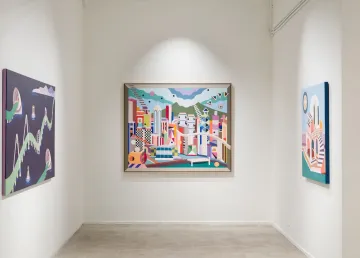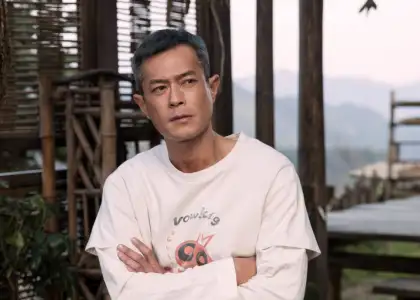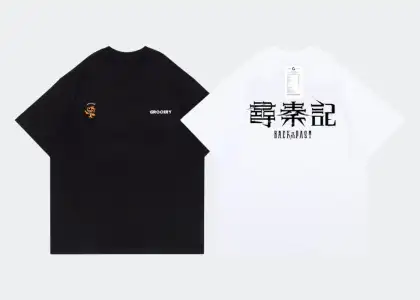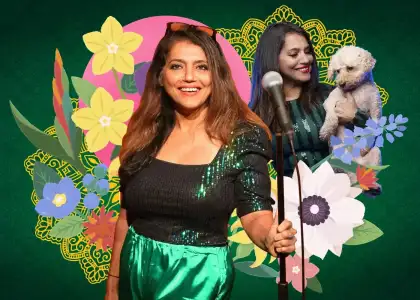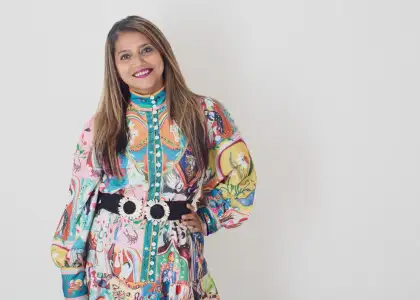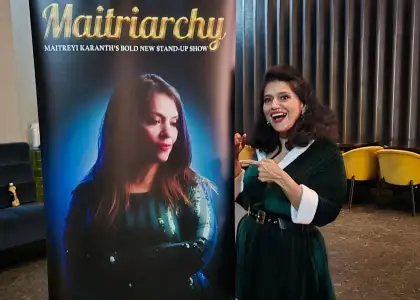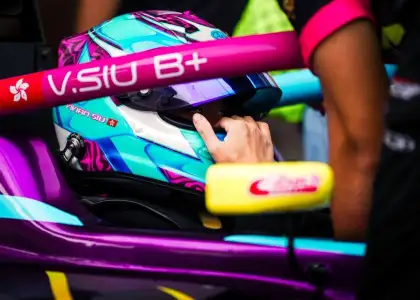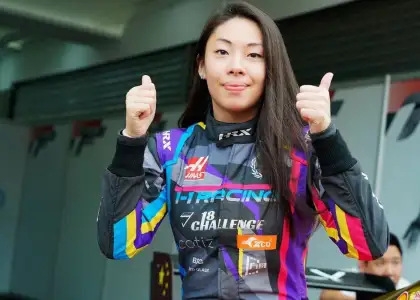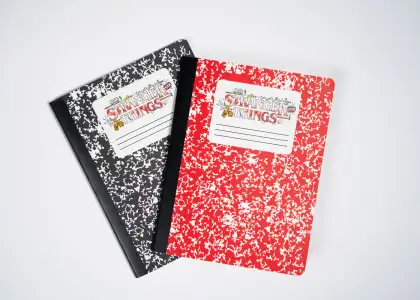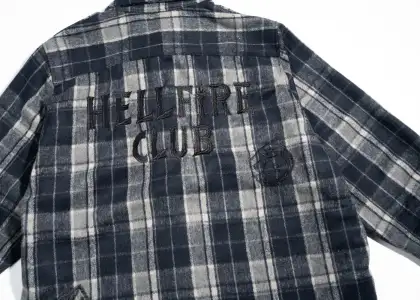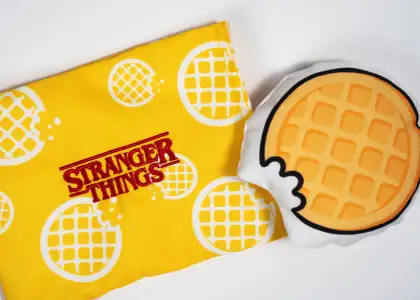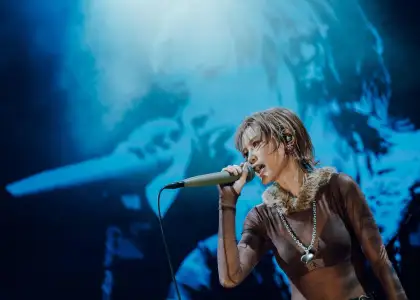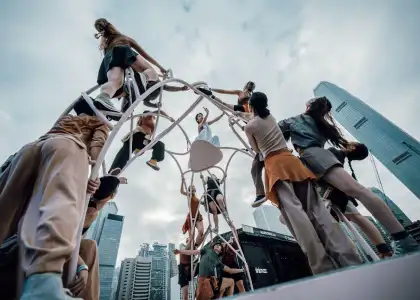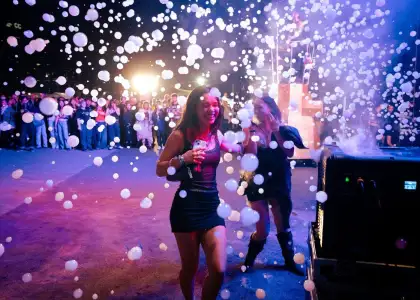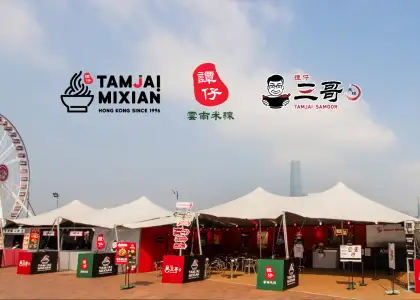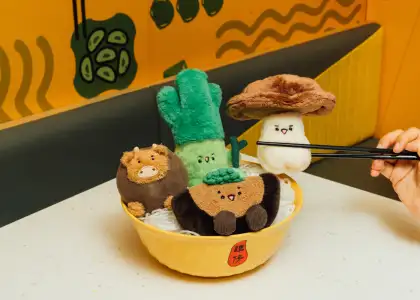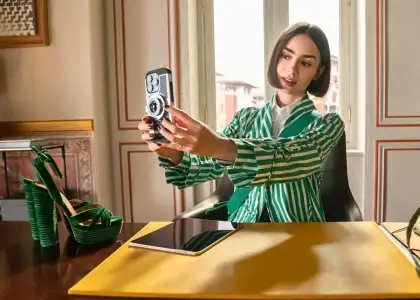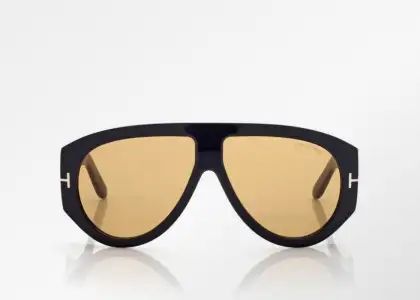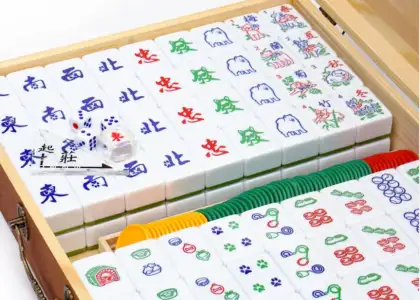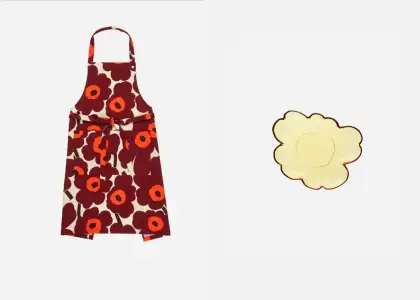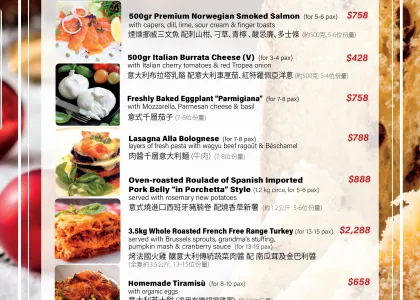Sophia Hotung, the 'Hong Konger' Artist Parodying Classic New Yorker Magazine Covers
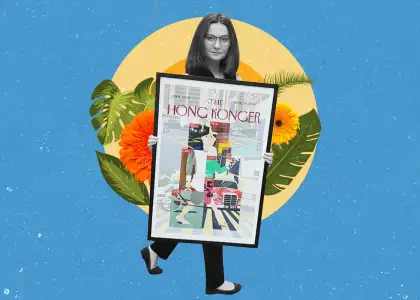
British-Hong Konger Sophia Hotung, 27, began her project subverting covers from the New Yorker magazine to encapsulate the minutiae of Hong Kong, first, as a joke. Bed-ridden with refractive autoimmune diseases, osteoporosis, and ME/CFS, the joke of drawing parodies of the famous magazine for her “Hong Konger” series, like all of her jokes, got out of hand.
After one lone meme parody posted on her Instagram in early spring 2021, reception warmed up and inspired the artist to produce countless more parodies.
In October 2021, Sophia debuted as one of Hong Kong’s newest modern artists at the premier Art Next Expo at Causeway Bay’s Lanson Palace Hotel. She stood amongst a collection of 500 posters, 65 artworks, and eight collector edition prints, representing herself and her parodic series to the public for the first time.
Her bright and popping “Hong Konger” parodies capture the intricacies of what it means for Sophia, a Eurasian, living in Hong Kong, caught between the colonial remnants of her ancestry and British Hong Kong and the Cantonese environment of which she grew up in.
“Originally, I wanted to show that Hong Kong is not just lanterns and opera music to a Western audience,” said Sophia in an interview with The Beat Asia. Using the New Yorker magazine as a basis for her artwork, the “Hong Konger” series explores the position Cantonese culture has in a Westernized Hong Kong and where the city stands in her journey as a disabled British-Hong Konger and the world landscape.

Sophia’s first magazine parody took shape in June 2021, satirizing one of the most famous magazine covers borne out of the New Yorker, “View of the World from 9th Avenue. The cover captures first-person view looking westward from 9th Avenue in Manhattan to Jersey, the rest of the contiguous United States, and the Pacific Ocean, positioning Manhattan as the centre of the world.
Originally a meme directed to her childhood friends, Sophia wanted to “rip off” this piece and create her first cover as the “view of the world from M&S [in Central Tower]” to mock expat culture in the city, heavily influenced by the British exports that are venerated and adored.
“Expats have a strong understanding of Stanley and Central,” Sophia explains, “a bit of TST, not that much of Kowloon, New Territories is rice paddies, and China is like...there.” To Sophia and many expats in Hong Kong, the M&S store in Central Tower acts as the “mecca of expat culture” in the city and represents the limit of knowledge of the territory beyond the large British chain store.

After warm reception from friends on Instagram, Sophia was spurred on to do another magazine cover, 1982 “Room with a View.” The New Yorker, a curious cat peering outside of the window to Manhattan. The Hong Konger, a dog eager to escape his small room in Sham Shui Po. “The first few [covers] (including ‘Room with a View’) were very literal artistic interpretations. Cat there, dog here, tea there, bubble tea here, lamp there, lantern here.”
She received a wealth of positive reception on Instagram and with friends and family, ultimately persuading her to aim to produce 12 more “‘Hong Konger”’ magazine covers for a calendar.

Twelve prints were too few. She received requests for covers on gay rights, wet markets, Soho, Kowloon, expats, and domestic helpers. The next plan was for a weekly calendar of 52 selected prints. Again, an easy target to reach. Currently, Sophia has produced over 70 distinct magazine covers and counting for her Hong Konger series.
The New Yorker magazine provided a good structure and template for Sophia to practice a variety of art styles and designs, not just be restricted to one artist. “The most perfect template,” Sophia calls it. Sometimes a cover can be copied literally from an American worldview to fit Hong Kong stereotypes. Other times, the overall artistic style and design of the cover can remain, but the issues dealt can be molded for a Hong Kong perspective.
The framework of the New Yorker and parody in the “Hong Konger” allows Sophia to explore and elaborate on the vast similarities and differences between her two homes, the capitals of the East and West.

Sophia is a child of two Eurasians and fourth generation of the Ho Tung family, a famous British-Hong Kong family hailing from Dutch-Irish-Jewish Sir Robert Ho Tung in 1862, nicknamed “grand old man of [British] Hong Kong” (香港大老; heung1 gong2 daai6 lou5).
Her rich ancestry, native to crown colony Hong Kong, is no interest to Sophia. She is not connected to the dynastic element of the old Ho Tung patriarch. She is, however, interested in the genetics of her ancestry and what it means for her to be a half British, half Hong Konger from Eurasian parents, exploring these childhood and ancestorial themes in her artwork.
Born in London in 1994, Sophia grew up in Hong Kong with her parents and older sister. She left Canadian International School, where she studied until sixth grade, in 2007, for boarding school for five years in her “sheep town” in Somerset, England.
When she turned 16 in the U.K., Sophia was diagnosed with autoimmune hepatitis - “everyone thought I had swine flu” - by local doctors and was interned at a local hospital for lengthy treatments. Her body’s immune system attacks the functions of liver and the cells, causing inflammation and great discomfort.
She took a year out of school to return to Hong Kong to be closer to family, before finishing her A-level certifications at Harrow International School in Tuen Mun. After finishing school, Sophia set her sights on studying at an Ivy League school in the U.S. or at Oxbridge.
Sophia packed her bags for the Big Apple to pursue a four-year degree in English Literature at Barnard College of Columbia University. She said she wanted to travel to New York for exposure to the city's art scene but also explore the opportunity of becoming a “corporate wench, being a good Hong Kong kid.”
She wanted an elusive career after New York but also to keep in touch with her hobby of creative writing and playwriting. “My mom is Eurasian so you never know if you're gonna (sic) get the tiger mom part or […] the soft Western mom part,” Sophia stated., “Her general belief is that it’s great to have hobbies, but you need to make money [too].”
Sophia graduated with a 3.95 GPA in 2018, found herself in an IT auditing position with KPMG in Edinburgh, Scotland, and gradually became sicker and sicker with her disease, due to overworking and long hours. She eventually became so sick that she couldn’t work anymore, deciding to move to London closer to her extended family.

After beginning in a job that required even longer hours and weekend schedules as a crisis communications analyst, Sophia’s health became debilitating. She was diagnosed with celiac disease and autoimmune cholangitis (immune system attacks the bile duct) in 2018, and ocular myasthenia gravis (immune system attacks nerves in eyes) in 2019. She moved back to Hong Kong in May 2019 when her health made it tough for her to continue living far away from her parents.
She began a job at Kids Gallery, her mother's children-focused art school, in the summer of 2019 working as a business development manager, amidst the protests and later COVID-19 pandemic. She worked until October 2020 when, on National Day, she could not physically get herself out of bed. She was put in hospital for three weeks, diagnosed with myalgic encephalomyelitis/fibromyalgia (blanket term for unknown fatigue-inducing diseases).
“My body was just like, we're not doing this anymore,” Sophia told The Beat Asia, “you cannot walk.” The last quarter of 2020 left her depressed, unable to wash her hair or prepare food, and questioning her whole existence. “My life previously was all based on what job I had. Now I had no job, no point in living, and at home at 26!”
At Christmas, Sophia received an iPad from her mother who did not know what to get her 27-year-old bedridden daughter. Sophia began using the iPad over holiday break and New Year, regaining her lost function in her wrists and fine motor control skills by painting using an art software app called Procreate.
“[Painting, sketching, and drawing] on the iPad were a good way for me to trick myself into doing the physio exercises I wasn't doing because it’s engaging enough that you want to keep drawing,” she said.

Her father began sending her tutorial books from the U.K. on how to draw, she began doodling memes, creative posters, and drew her first replicated parody of the New Yorker magazine in March 2021. Seventy-one published magazine covers later, Sophia’s mother-approved hobby has now become a full-time job.
Sophia’s drawing process is simple. During the beginning of her series in mid-2021, Pinterest was a main source to locate New Yorker covers and “churn” out designs, producing literal artistic copies to fit a Hong Kong perspective. Currently, her selection process is more refined.
Either Sophia sees a New Yorker cover that she would like to literally translate to cover a small detail of Cantonese culture, or she has a local Hong Kong topic that she wants to portray and searches for an appropriate cover aligning a similar topic in Hong Kong.
Her main decision with each cover goes down to whether to emulate the same style or keep a similar content of each New Yorker. For example, her “St. John’s Cathedral” cover uses different shapes and content, but has similar style to the New Yorker version: imitation of the line drawing, muted saturation, 2D perspective.
“Day Off” employs the style and emotions of an old 1942 cover of the New Yorker of munitions workers on a factory break to portray the toil of Hong Kong’s foreign domestic workers on their weekly Sunday break in Causeway Bay.
Whilst not explicit, some covers take on a deeper emotional meaning for Sophia. “Lion Rock Station” encapsulates Hong Kong’s disabled communities’ – her included - plight with navigating the torrid urban landscape of the city and the expansive MTR system: you can travel anywhere but there is no guarantee it’ll be easy nor a wheelchair exit on the other side; you can get up to the station, but no way to leave, nor wheelchair exit on the other side.
“Bao Bei’s Feast” features a Eurasian toddler who only craves a Happy Meal despite a massive Chinese banquet spread out before her. An ode to her battle with celiac disease, Chinese food, frequently made with gluten-filled soya sauce, has been a longstanding issue of Sophia “not being Chinese enough” and “losing touch with her heritage” unable to consume most Cantonese cuisine.

“Negative trolls are everywhere” and don’t bother her, Sophia explained in our interview when speaking on reception for her art. Conversely, “[p]ositive things aren’t fun to talk about because they’re always nice.” Sophia prefers to stay under the radar so as not to upset those who believe she is appropriating Canto-Hong Kong.
“Some people think I’m racist because I’m appropriating Chinese culture in my artwork, mocking the food, the Zodiac signs, poverty in the city, migrant workers. I am a white girl with Chinese heritage so a lot of people don’t understand where my art inspiration and love for the city is coming from.”
The positive reception has encouraged Sophia to pursue art as a full-time job for now. She has been and felt markedly healthier after recovering from an experimental monoclonal antibody infusion in June 2020, which “really turned things around” and made her “more functional” than previously before.
Speaking on her recent explosion of success in the Hong Kong art scene, Sophia said she feels like “a windshield and bugs are just hitting me. Like nice, pretty bugs are hitting me and I'm like: okay, cool. We'll just go with it and see what happens."

Her recent inclusion at the Art Next Expo in October 2021 was the next step in Sophia’s exponential growth as a new artist in Hong Kong. After seeing an advert in the MTR and applying on a whim, Sophia landed an exclusive space in the art exhibition.
Sophia’s future, as an artist and an individual, is however predictably unpredictable, reliant on the status of her autoimmune diseases to function healthily. A relapse in her condition and a lengthy hospital stay is always imminent if Sophia outworks herself, so she routinely turns down opportunities for commissions and work to prioritize her health.
In December 2021, her anthology coffee table book releases to the public. The book features 70 of her favorite “Hong Konger” prints, 70 city-centric poems produced by herself, and a space for Sophia to explain the historical and cultural significance of the stories behind each Hong Konger. Preordering is available now via her website.
Additionally, Sophia is working on a project for early 2022 that will produce a children's series of crime novels set in the gritty night city streets of Hong Kong, based on her research of the citys underworld and inspired by the literature of Agatha Christie and Alexander McCall Smith.

Subscribe to The Beat's newsletter to receive compelling, curated content straight to your inbox! You can also create an account with us for free to start bookmarking articles for later reading.



